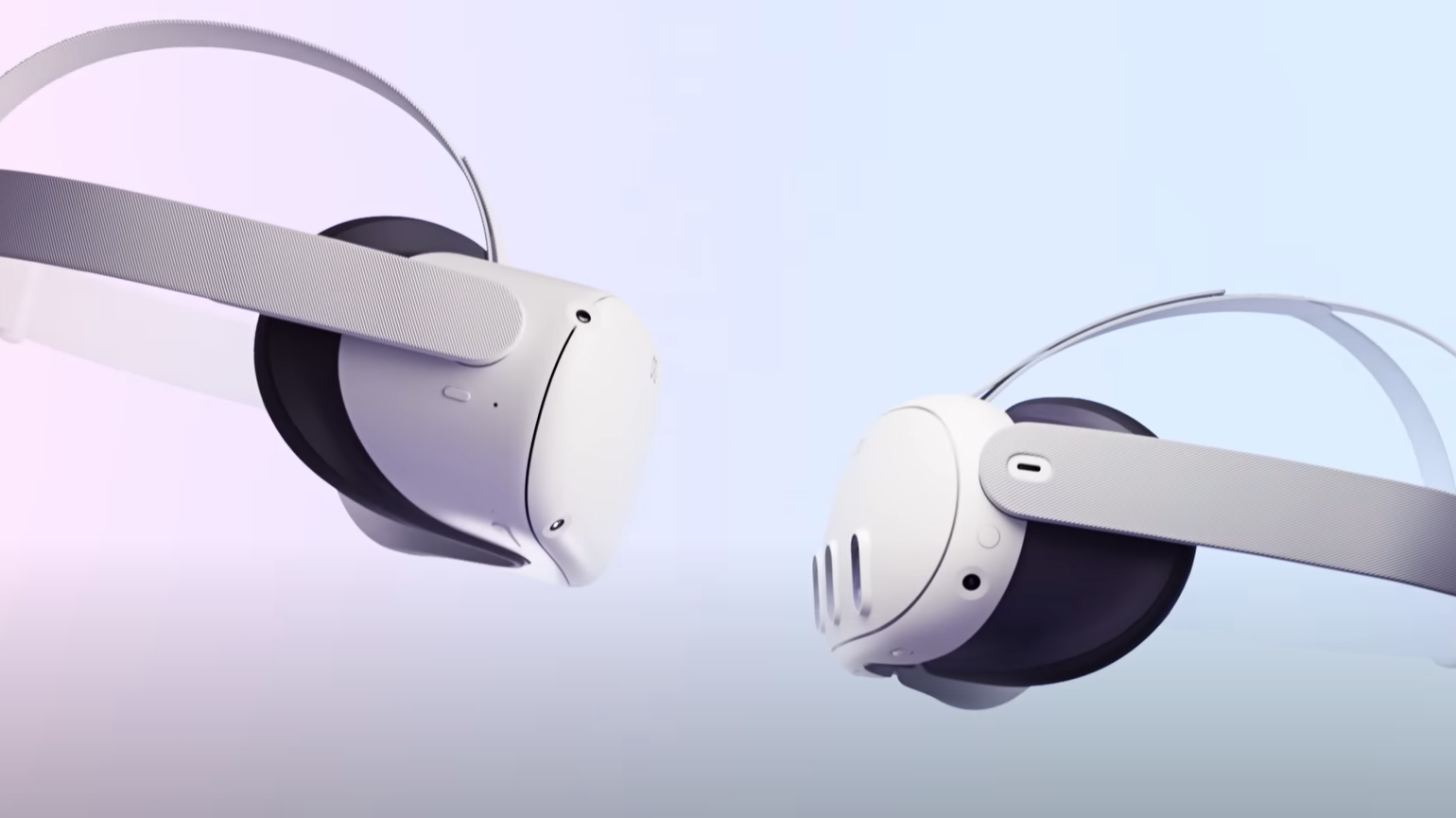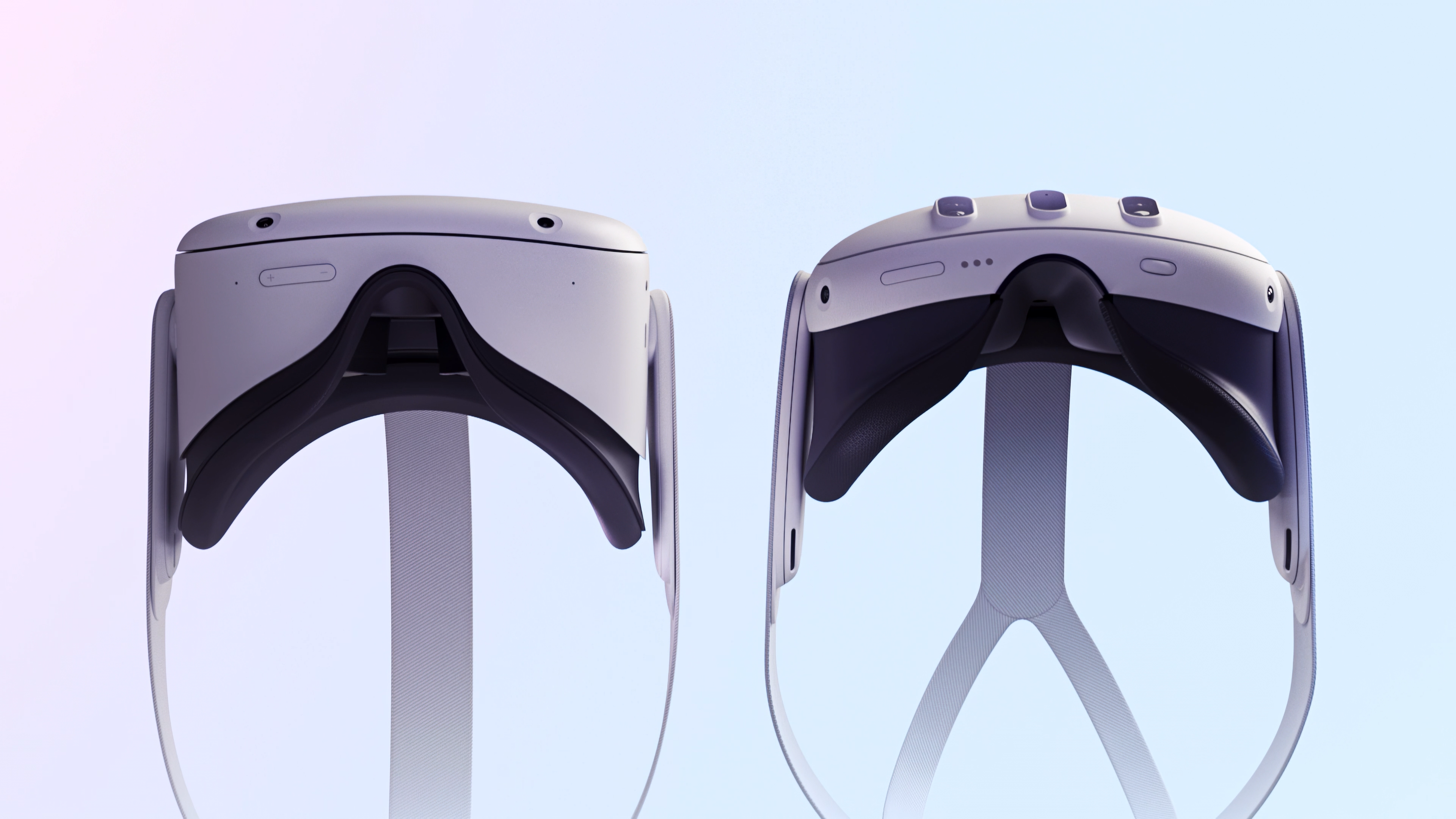
Now that the Meta Quest 3 is finally officially announced, it’s time to pit it against our current pick for the best VR headset as part of a Meta Quest 3 vs. Meta Quest 2 showdown.
Unlike the Meta Quest Pro — which, in retrospect, seems to be a VR headset that was never meant for average users — the Quest 3 feels like a true step forward from the Meta Quest 2. Both headsets even look largely similar, though the Quest 3 is noticeably slimmer and features some extra hardware on the front of the headset visor.
One place the headsets differ greatly, however, is price. The Meta Quest 3 will start at $499 for the 128GB model when it launches in the fall, whereas the Quest 2 is about to get a serious price reduction. So there’s a real argument to be had about which headset to get despite the fact that the Quest 3 is a clear improvement.
To help you decide, here’s a Meta Quest 3 vs. Meta Quest 2 comparison that highlights the key differences between headsets.
Meta Quest 3 vs Meta Quest 2: Specs
Meta Quest 3 vs Meta Quest 2: Price and availability
Price is probably the biggest thing in the Meta Quest 2’s favor. It’s currently $399 for the 128GB model and $429 for the 256GB model. However, in Meta’s blog post announcing the Meta Quest 3, Meta announced a massive price cut for its current-gen VR headset.
Starting June 4, the Quest 2 will cost just $299.99 for the 128GB model and $349.99 for the 256GB model. That makes it a whopping $200 cheaper than the $499 Meta Quest 3 with 128GB storage. Meta has said that there will also be a Quest 3 with more storage available, but details have yet to be announced for this upgraded model.
So if price is your main consideration, you may want to consider the Quest 2. You can get it now from the Meta online store in both storage sizes. If you want the Quest 3, you’ll need to sign up for updates on the Quest 3 product page. The headset is not yet available for pre-order and is expected to launch at Meta Connect on September 27.
Meta Quest 3 vs Meta Quest 2: Design

For a headset that is “reimagined and redesigned,” the Meta Quest 3 looks a lot like the Quest 2 at first glance. But if you take a deeper look at the two headsets you’ll notice some massive differences.
Namely, according to Meta the Quest 3 is 40% slimmer than the Quest 2. And when you look at the two headsets side by side the Quest 3 is noticeably slimmer. This is partly due to pancake optics, which allow for higher-resolution lenses in smaller spaces by layering optical film.
In addition to a slimmer form factor, the Quest 3 also gets a brand-new camera array on the front of its visor. This array includes dual 4MP RGB color cameras and a depth sensor in between them. This not only allows for a more accurate representation of the area you’re using the Quest 3 in but it also allows for full-color video passthrough.
Aside from these changes, there are a few other tweaks. Instead of needing to grab a lens to adjust the IPD of your lenses, the Quest 3 introduces a wheel to adjust IPD, which should be a significant quality of life improvement. Additionally, the top strap is a Y-shape rather than a straight line back, which should allow for a more secure fit.
The speakers also appear to be moved to drive sound down rather than towards you, but it’s unclear what benefit this will provide yet, if any. Hopefully, it just improves on the Quest 2’s speakers, which are already surprisingly good.
Meta Quest 3 vs Meta Quest 2: Displays

The Quest 2 display is fine, but it’s been surpassed by its competitors. The 1832 x 1920 per eye resolution lags behind the PSVR 2, which features twin 4K OLED, 2,000 x 2,040 displays. However, it is in line with the Meta Quest Pro, which features the same 1832 x 1920 per eye display resolution.
Unfortunately, Meta Quest 3 display details are currently scarce. The only crumbs Meta has dropped for us is that “Quest 3 combines our highest resolution display yet and pancake optics to make sure content looks better than ever.” So while we can’t be sure about the final display resolution, we are confident that it will be an improvement from the Quest 2 and Quest Pro.
Meta Quest 3 vs Meta Quest 2: Controllers

The Quest 2 controller’s iconic tracking ring is gone with the Quest 3 touch Plus controllers. These new controllers adopt the sleeker look of the Quest Pro’s Touch Pro controllers but annoyingly lack the Pro controller’s cameras, so there are some slight concerns about potential tracking issues. However, the Quest 3 will support hand tracking from launch, so maybe outside of gaming, you won’t need to use controllers as much.
It also seems that the Quest 3 will continue Quest 2 controller’s reliance on disposable batteries, but we aren’t quite sure yet. There was no reference to rechargeable controllers in Meta’s announcement, but it's not impossible that the feature isn’t being saved for a reveal at Meta Connect in September.
One feature that wasn’t saved for Meta Connect? TruTouch haptics. This feature integrates haptic feedback into the Quest 3’s Touch Plus controllers, stealing a popular feature from the Touch Pro controllers.
Meta Quest 3 vs Meta Quest 2: Performance

Like with display resolution, Meta hasn’t given us a ton to go off of when it comes to performance. But what they had said has been pretty definitive.
In its official announcement, Meta called the Quest 3 "our most powerful headset yet." The headset will feature a yet-to-be-named next-generation Qualcomm Snapdragon SoC chipset that Meta says “delivers more than twice the graphical performance as the previous generation Snapdragon GPU in Quest 2.” Meta says more details will come later this year.
This could refer to a version of the Qualcomm Snapdragon XR2+ used in the Meta Quest Pro or could be a new chipset entirely. All we know is that it should be an improvement on the Qualcomm Snapdragon XR2 used in the Quest 2.
Meta Quest 3 vs Meta Quest 2: Battery life

Currently, the Meta Quest 2 is rated at 2 to 3 hours of battery life, though this depends on the activity. When I watched Cocaine Bear in VR, it drained probably around half my battery in 90 minutes, but VR gaming will drain it faster.
At the moment, Meta has yet to give us any hints on the battery life of the Quest 3. Heck, we haven’t even seen a leak or rumor. However, it would be bitterly disappointing if the Quest 3 can’t at least make it 3 hours.
Meta Quest 3 vs Meta Quest 2: Games

Great news if you’re thinking about getting the Quest 3 — it’s going to be backward-compatible with the entire Quest 2 games library. That means you can play all 500-plus Quest 2 games at launch, including the new ones announced at the Meta Quest Gaming Showcase 2023.
Currently, we haven’t seen anything announced that won’t work on Quest 2 that will be playable on Quest 3, but we expect it to happen eventually. The combination of a better processor and new mixed reality features makes it more likely than not that developers eventually take advantage of the Quest 3’s advantages.
But most games — for now — will probably come out on both. Meta has no intention of giving up on the Quest 2 just yet, viewing it as the true entry point into the Meta VR ecosystem. An upcoming software update will boost the Quest 2 chipset with a maximum 26% CPU performance increase and a GPU speed increase of up to 19%. for Quest 2. This update will also enable Dynamic Resolution Scaling for the Quest 2 to improve frame stability with the new, increased pixel density.
If you’re looking for a place to start gaming, check out our guide to the Meta Quest 2 games you should play first.
Meta Quest 3 vs Meta Quest 2: Mixed reality features

Mixed reality is the biggest difference between the two headsets. The Quest 2 has essentially no mixed reality features — it’s a VR headset. There is black and white video passthrough, but it’s incredibly limited and mostly so the Quest 2 can tell where you are in a room.
The Quest 3 though, looks set to take advantage of its full-color video passthrough. The Quest 3’s camera array and depth sensor combine to accurately represent the space you’re in and the cameras have 10 times the pixels of the Quest 2’s black and white cameras.
Meta has yet to show off its full vision for mixed reality on the Quest 3, but in the announcement video, it did give us a sneak peek. At one point, a Quest 3 user is playing the VR game Demeo and instead of being forced to play on a virtual tabletop, they are playing on the table in front of them.
Meta Quest 3 vs Meta Quest 2: Which is best for you
The good news is that it really does appear that Meta wants to keep the Quest 2 around as part of its product line of VR headsets. With the incoming price reduction to $299 and continued software updates to improve performance, getting a Quest 2 now won’t be a wasted investment. While Meta will one day set it aside for the Quest 3, it doesn’t seem like that day is any time soon.
But if you want an experience that takes you between virtual reality and the real world in one headset, the Meta Quest 3 appears to be the clear choice. Its $499 price point may not feel like great value when the headset launches, but if developers start making games and apps that take advantage of the Quest 3’s mixed reality capabilities, it could become the best VR headset for most people.







